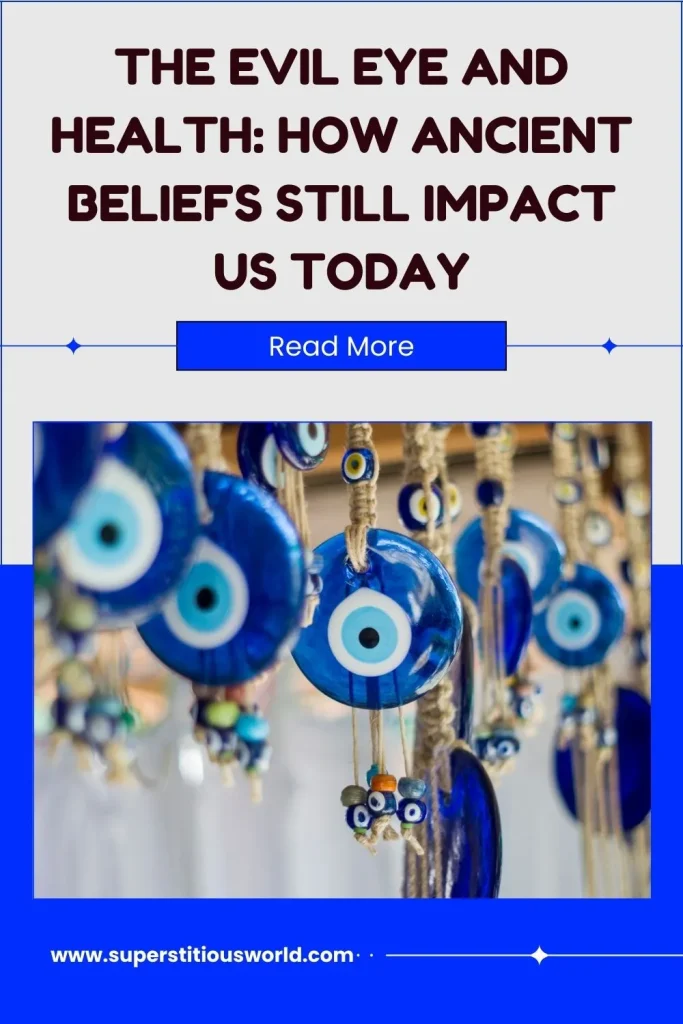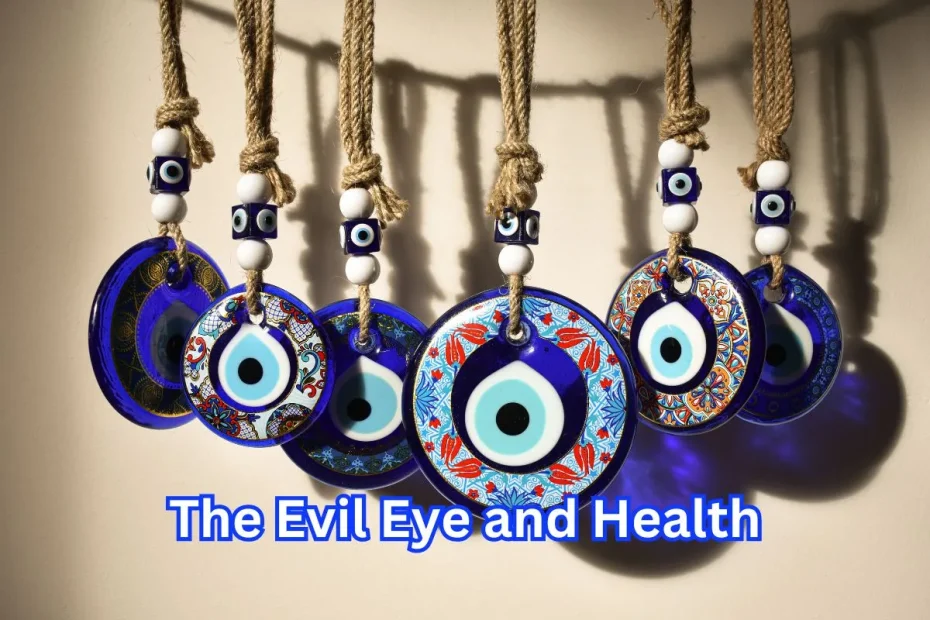The concept of an “evil eye” has, throughout history, deeply permeated many cultures. This ancient concept, rooted sometimes in the idea that a malevolent glare can cause harm or misfortune, appears to continue on into our present-day view of health and spirituality. Although many view this belief as no more than superstition, it is a belief genuinely held by many around the world.
In this blog, we trace the origins of the evil eye and its connection with health-related beliefs, reflecting how such ideas resonate in our contemporary world.

READ NEXT: Why Avoiding Certain Foods Is Tied to Old Health Superstitions
Key Takeaways
- The evil eye is a superstitious belief within many cultures in which an evil eye stare can bring misfortune, injury, or death to the targeted individual.
- Symptoms attributed to the evil eye include headaches, weariness, and stomach discomfort, which link cultural beliefs with personal experience of health.
- In modern times, the evil eye often interconnects with holistic healing practices, blending that ancient spiritual knowledge with today’s approach to health.
- Despite scientific development, people’s spiritual beliefs still appear to be dominated by the evil eye-a modern manifestation of that age-old interplay between culture, community, and well-being.
What is the Evil Eye?
The evil eye is a belief that envy can inflict harm on a person, usually in the form of a glare. Known under many names in various cultures—malocchio in Italian, nazar in Turkish, ayin harsha in Hebrew—its impact is believed to manifest in various negative ways, from illness to personal misfortune.
Origins and Cultural Significance
The belief in evil eyes has nothing to do with any region or religion in particular. It goes as far back as the ancient Greeks, Romans, and Mesopotamians, all of whom believed that people could make others experience bad luck just because of the way they looked at them. It cropped up with the belief that envy or jealous intentions can visibly give out negative energy toward another person’s good health, well-being, or happiness.
While the evil eye emanates from an ancient root, it has lived to its effects to this day through the Mediterranean, Middle East, Latin America, and beyond. Most people in these regions wear different amulets or talismans prepared with an eye to dissipate negative energy.
These charms are generally called nazar in Turkey and hamsa in some cultures of the Middle East, not merely for signs of superstition but cultural artifacts taken toward the service of protection against harm.
In fact, you will still notice remnants of this belief in various ways even in contemporary religions: one finds protective practices and prayers meant to protect individuals against malevolent forces in Christianity, Islam, Hinduism, and Buddhism. The thread running in common is that the protection desired to be accorded against envy and misfortune has been an ever-present desire among people.
The Evil Eye’s Connection to Health
Backers of the evil eye commonly associate it with physical and emotional stress. Generally, the symptoms associated with the evil eye are as follows:
- Unending Headaches: Many people consider unrelenting headaches as a classic symptom of being under the spell of an evil eye.
- Suddenly Feeling Fatigued: When there is no apparent cause of tiredness, it can be blamed on the negative energy of the evil eye.
- Digestive Problems: Pains in the stomach, including bloating or discomfort, are often associated with envy and jealousy.
- Malaise Emotional: The evil eye may be expressed in anxiety, depression, or sudden swings of character.
These symptoms are fascinating, as they indicate how cultural beliefs interlink with concepts of personal health. A person overcome by sudden sickness or a mood change might not seek out medical intervention, but rather might resort to folk remedies or spiritual guidance in the belief that the symptoms reflect envy rather than a medical problem.
The Modern Perspective
Even in today’s world, where scientific knowledge continues to grow immensely, people still support such beliefs. In this day and age, the concept of nazar basi/nazar lagna has taken on a whole new form—social media.
On platforms like Instagram and Facebook, lives are being shared more and more, often inviting envy or unwanted attention into someone’s life. To others, this exposes them more to the evil eye’s power. If misfortune ensues after a social media post about a new job, relationship, or vacation, one won’t be surprised to hear people say, “It’s the evil eye.“
This indicates a more general human tendency to explain unexpected and/or unaccounted misfortunes in terms of culture and/or spirituality when the use of reason might better serve human interests.
Traditional Remedies Against the Evil Eye
Most cultures have developed certain rituals that can ward off the evil eye or “cure” its effects. Examples of such remedies include:
- Ruqyah: In Islamic culture, believers recite specific verses from the Quran to protect against the evil eye and bad energy.
- The Olive Oil and Water Rituals: One of the very common Mediterranean practices is dropping olive oil into water in order to diagnose or treat a person afflicted by the evil eye. If the oil spreads in one particular way, this will mean the person is suffering from envy.
- Protective Amulets and Talismans: Signs like nazar or hamsa are worn as jewelry or hung in homes in order to ward off malevolent stares.
- Smudging: The act of burning specific herbs—sage or frankincense, for example—to cleanse the air and rid a place of negative energy.
While different regions and different religions have variants in regard to these practices, the essence behind them remains similar: to ward off negative forces and bring harmony back to the affected individual. Most people continue to rely on these practices today, marrying spirituality with a holistic approach toward health and wellness.
Family Traditions and Generational Beliefs
The beliefs in the evil eye are passed on and adopted from generation to generation. In those families where the traditions run deep, the younger members may continue to practice them more out of respect than actual belief. For example, Italian families might diagnose an illness with the olive oil and water ritual that their grandparents did, serving as a cultural bridge in connecting generations and perpetuating cultural identity.
Psychological Effects of the Belief in Evil Eye:
1. Anxiety and Fear
The belief in the evil eye can cause major psychological effects. People, therefore, may be very cautious or secretive about their personal success. This fear can further cause anxiety, as they will be apprehensive whether their social interactions or even their possessions or success are bringing the deadly energy.
This might also exacerbate mental health issues, such as social anxiety or obsessive-compulsive behaviors, while people try to “protect” themselves from perceived threats. The evil eye could lead to behaviors such as not using social media, refusing to discuss any of one’s personal accomplishments, or conducting repetitive rituals to ward off the negative energy.
2. Strengthening Community Bonds
On the other hand, belief in the evil eye allows for bonding and shared experiences. Most of these cultures bring people together through envy concerns into some form of protection through community rituals or prayers. It is such communal gatherings that make for strong bonds, emotional support, and reinforcement in cultural identity.
In this way, belief in the evil eye functions both for social cohesion and for the protection of the individual. This belief in the evil eye provides them with a degree of agency vis-à-vis their well-being within a world that sometimes appears arbitrary or opaque.
The Evolution of Beliefs About Health and the Evil Eye
1. From Superstition to Science
As time passed, with the development of modern science, people began to turn away from superstitions such as the evil eye and develop medical and psychological interpretations for the rise of ailments and misfortunes.
Thus, for most headaches, fatigue, digestive issues, and emotional disturbances, the villains have become stress, nutrition-related problems, or psychological disorders.
Nevertheless, the belief in the evil eye survived in a number of ways, especially in holistic or alternative healing. The mixing of ancient spiritual wisdom and health practices has become increasingly popular, from energy healing and mindfulness to chakra balancing.
People strive to seek out methods that can combine both physical and emotional healing since they understand very well that well-being is multi-dimensional.
2. Ancient Wisdom Combined with Modern Health Practices
With the increase in focus on science and medicine, there seems to be a returning urge to garner ancient wisdom into health practices. A lot of people feel that it is not enough to take care of the physical aspects of health alone, but also consider the energetic and emotional parts as being equally important.
This is why healing modalities like reiki, crystals, and meditation practices are still grounded in the wisdom traditions that believed in the evil eye and continue to hold sway over some people’s perceptions of well-being.
Thus, we can see that although the evil eye as a supernatural force might seem old-fashioned, its spiritual significance persists, reframed within a broader holistic understanding of health.
Final Thoughts
In conclusion, while some may brush off the belief in the evil eye as no more than an ancient superstition, its connection to cultural health and well-being serves to remind us that people’s mental, spiritual, and physical experiences are often deeply interwoven across both time and space.
READ NEXT: The Surprising Health Superstitions People Still Believe In
READ NEXT: The Healing Power of Crystals: Belief or Superstition?
References
[1] https://tulanemagazine.com/the-power-behind-the-evil-eye/
[2] https://simplyislam.academy/blog/symptoms-to-determine-if-you-are-afflicted-with-the-evil-eye
[3] https://www.radicisiciliane.com/blog/malocchio-a-brief-understanding-and-offering
[4] https://thewalrus.ca/i-believe-in-the-evil-eye-and-you-should-too/
[5] https://wendyouali.wordpress.com/2019/09/22/the-evil-eye/
[6] https://www.worklifecentral.com/Blog/Devinders-blog-The-Evil-Eye-of-Toxicity.htm
[7] https://www.ashlinakaposta.com/blog/evileye
[8] https://www.kosterina.com/blogs/news/weekly-wellness-the-evil-eye



